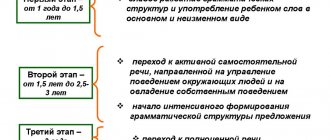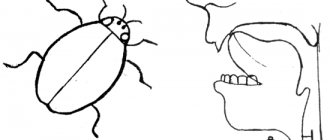The psychomotor development of a young child is an integral part in understanding the world around him and preparing for later life. Preschool age is characterized by a number of changes and metamorphoses, which determine who the little person will become. How can adults understand whether everything is okay and whether specialist help is needed? So, first things first.
What happens in the first 4 years of life
The first four years of life are an important period for a child's development. It is at this moment that the formation of qualities and skills begins. The baby shows interest in the world around him, learns to trust people, develops general self-esteem, etc. In addition, the following processes undergo physiological maturation:
- motor skills;
- sensory;
- speech;
- emotional sphere, etc.
The psychology of 3-4 year old children is changing, thus adapting to independent life. This age is characterized by a break in character, the task of parents is not to break it, but to guide it, so adults need to be patient and wise, adequately perceive children's whims, and calmly explain: what is good and what is bad.
At 3-4 years old, the child’s behavior begins to take on new shades, which sometimes discourages mothers and fathers. The baby becomes capricious, uncontrollable, whiny, and stubborn. Many parents often make a mistake and begin to hobble their children in an authoritarian manner. This approach is incorrect and only generates negativity, developing a number of complexes.
However, there are several types of pathologies that are not recognized by parents in a timely manner. At the age of 3-4 years, a number of psychomotor development disorders appear (autism, speech delay, etc.). Sometimes the diagnosis of such conditions is delayed due to the inattention of loved ones and teachers. Therefore, in order to prevent the development of severe and irreversible disorders, their timely identification and correction is necessary.
What does a psychologist evaluate?
Psycho-emotional status of children 3-4 years old (younger group), which is characterized by physical and mental state.
Physical development: assessed by coordination of movements, performing simple movements (jumping, squatting, overcoming simple obstacles, etc.). Fine motor skills are also assessed, namely the synchronization of hand movements.
To assess a child’s speech development at a young age, it is necessary to determine his vocabulary, which should not be passive. Namely, understanding the meaning of a story or conversation, requests. The presence of a certain volume of words that denote household items, clothing, toys, etc.
The child’s vocabulary, which he actively uses in his speech, must be characterized by a semantic basis. During this period, he must have an idea of the concept of “letter” and know several vowels. Be able to compose a simple story based on questions or the availability of visual material. The child masters concepts that generalize objects:
- utensils (pot, frying pan, forks, spoons, etc.);
- toys (doll, car, lego, ball, spinning top, etc.);
- furniture (table, chair, bed and other items), etc.
Mental development is assessed based on acquired skills:
- attention – the child is able to concentrate on an object for 4-5 minutes;
- memory – can remember about five objects and names them after a few minutes;
- thinking - the baby must know everything about himself (his name, how old he is), the names of surrounding objects, can compare them by size, knows several geometric shapes, the names of colors. Has an understanding of numbers, can count from 1 to 10. The offer of a new toy arouses interest, he understands how to play with it;
- imagination – the ability to complete a started image;
- emotional development – when meeting someone, he responds with goodwill and makes contact easily.
Article:
Currently, there are several approaches to diagnosing the mental development of young children, both in Western and domestic science.
In foreign literature, diagnostics of early child development is carried out primarily by testing. This method is based on the assessment of a number of behavioral manifestations, correlated with a normative indicator characteristic of healthy children at a certain age. Most tests for infants are designed to diagnose sensorimotor development (the ability to hold the head, manipulate objects, sit, turn, follow objects with the eyes, etc.)
Tests for early childhood are typically scale-type (eg, Binet-Simon Intelligence Scale or Stanford-Binet Intelligence Scale). Such methods include a certain range of standards - criteria that are the basis for assessing the child’s mental development in various areas (sensory, motor, emotional communication, speech development, etc.). Assessment of the level of development is based on the success of completing a normative task or detecting a particular ability (for example, moving towards an object and grasping it). The standards are correlated with the age of discovery of this ability in a representative sample of children. Based on a comparison of “mental” and “chronological” (passport, biological) ages, quantitative and qualitative indicators of the level of mental development of the child are calculated.
The prerequisites for the development of normative scales were created during research and observation of the mental development of children (V. Stern, E. Clapareda, S. Buller, etc.). The most important condition for the emergence of the group of methods under consideration was the creation of psychometric scales for the study of intelligence. One of the first tests for infants was a version of the Binet-Simon scale, proposed by F. Kühlmann in 1912. In this version, tasks similar in nature to the tasks of the main scale were used, as well as indicators of psychomotor development.
The most well-known scales in the history of psychological diagnostics for studying children in the first years of life are A. Gesell’s “Development Tables,” which include norm indicators in four areas of behavioral manifestations: “motor skills,” “language,” “adaptive behavior,” “personal and social.” behavior". This diagnosis is based on a standardized procedure for observing the child in everyday life, assessing the reaction to toys, and taking into account information provided by the child’s mother. The examination is facilitated by a detailed description, complete with drawings, of the procedure for observing behavior typical of children of different ages. This scale is intended for the age range from 4 weeks to 6 years.
The experience accumulated by the school of A. Gesell formed the basis for the development of the method of S. Büller and G. Getzer, “Tests of neuropsychic development of children 1-6 years of age,” which was very widespread in the 30-40s of the 20th century. Based on A. Gesell’s tests, the “Psychomotor Development Scale in Early Childhood” was also developed, proposed by O. Brunet and I. Lezin, which was intended for the study of children aged 1 to 30 months. The scale contains 160 items related to child behavior in four areas: motor skills, hand-eye coordination, speech development, and social development. Normative development criteria are arranged in accordance with age levels (a total of 16 levels are identified). For each completed task a certain number of points are awarded. When processing the results, the sum of the points received by the child is divided by 10. The final indicator reflects the “global age” of development of the child under study. By correlating global age with chronological age, the “development coefficient” (QD) indicator is determined. The scale is adapted to assess the four behavioral domains under study separately. The results can be expressed in the form of profile assessments.
Another “Development Scale” was proposed by D. Lashley (Laishley Scales in Infant Development). She developed an observation scheme that allows one to get an idea of the child's development at the time of observation. Periodic observations throughout early childhood make it possible to judge the dynamics of the child’s development during this period. Lashley's cards reflect the following areas of development:
– physical development (development of movements, locomotion and motor skills);
– communication and speech development (attention to adults, understanding speech, etc.);
– social development and play (involvement in communication, vocalizations, exchange of toys);
– autonomy and independence (how much time a child can occupy himself during the waking period);
– characteristics of the child’s behavior (restlessness, concentration, ease of inclusion in the game, etc.)
The methodological feature of the observation process, according to Lashley, which she called the “method of time-based samples,” consists in the regularity of observation over pre-marked time periods. So, one option is to observe the child for 30 minutes. with recording of impressions every 30 seconds. Information received about a child is assessed in two ways: a) by comparing the child’s indicators with the average indicators of children of a given age; b) comparing the information received about the child with his results at an earlier age.
Recently, the “N. Bailey Development Scales” (Beyley Scales of Infant Development, 1969) have found widespread use abroad - the result of many years of scientific research by N. Bailey and her colleagues at the University of Berkeley. This technique is intended for examining children aged 2 to 30 months. The test suite consists of 3 parts:
1. Mental Scale is aimed at assessing sensory development, memory, learning ability, and the beginnings of speech development. The result of the measurement is the “mental development index” (MDI).
2. Motor Scale measures the level of muscle coordination and manipulation. The result of the measurement is the “psychomotor development index” (PDI).
3. The Infant Behavior Record is designed to record emotional and social behavior, attention span, persistence, etc.
Norms for the scales were established on a sample of 1262 children. Developmental indices, determined using mental and motor development scales, are expressed in a standard IQ rating scale. Scale scores are established for each age group, which are compiled at half-monthly intervals for children from 2 to 6 months and per month for children from 6 to 30 months. There is evidence indicating the high validity of these scales. According to A. Anastasi, the Bayley scales compare favorably with other methods for young children and are very useful for the early recognition of sensory and neurological disorders, emotional disorders and negative environmental influences on the development of a child. At the same time, Bailey herself noted that her scales, like other scales for infants, are suitable for assessing the level of current development, but not for predicting future development.
A great contribution to the development of child diagnostics was made by methods built on the basis of the theoretical system of methodological approaches of J. Piaget. The core line of his theory is the idea of the consistent, step-by-step nature of a child’s intellectual development. This development represents a natural change of periods and stages from birth to adulthood. Piaget's techniques are qualitative and have not been standardized for diagnostic purposes. However, some of Piaget's techniques served as the basis for new standardized scales. One of them was created by I. Uzhgiris and J. Hunt and is intended for children from 2 weeks to 2 years. This age corresponds to the period that Piaget calls sensorimotor and within which he distinguishes six stages.
The scale consists of 6 tests of increasing complexity - from simple eye tracking of a moving object and finding it (object permanence test) to identifying patterns of action with objects (stringing beads, driving a toy car, etc.). I. Uzhgiris and J. Hunt allow the use of the scale they developed for research purposes, in particular, to determine the influence of upbringing conditions on the course of children's development. Their research showed that the average age at which a child reaches different stages of development largely depends on the conditions of upbringing.
In domestic science, the first methods aimed at diagnosing the development of infants were developed in the 20-30s. XX century. At that time, the reflexological approach dominated in the study of infant development, from the position of which all mental manifestations were considered as a reflection of certain stages of maturation of the nervous system. The child's behavior was interpreted as a chain of disparate or interconnected reactions. N. M. Shchelovanov was the first to formulate the principle according to which the readiness of the functional structures of the brain creates the possibility of the occurrence of certain reactions, and the fact of their occurrence is determined by the corresponding educational influences. Mental development, from this point of view, was reduced to the sequential appearance of separate groups of reflexes.
One of the first works devoted to the diagnosis of infant development is “A brief diagnostic scheme for the development of a child up to 1 year” by I.L. Figurina and M.P. Denisova (1926). In the 40s N.M. Shchelovanov developed “Indicators of the neuropsychic development of children in the first year of their life.” The development contained criteria for assessing the level of mental development of children aged 2 to 13 months. This set of normative criteria was supplemented by N.S. Aksarina. The age range of the study was expanded to include children from birth to 3 years. Later, at the Department of Physiology of Child Development and Education of the Central Institute for Advanced Medical Studies, a “Methodological Development” was created, recommended for use in orphanages or nurseries (based on materials by N.M. Shchelovanova, M.Yu. Kistyakovskaya, E.L. Frukht, G. V. Gridneva and others). These methods were developed by accumulating a bank of data establishing a correspondence between the child’s reactions and the age of their onset, on the basis of which a judgment was made about the characteristics of the child’s mental development in the categories of compliance or non-compliance with the developmental norm. The main indicators of the neuropsychic development of a child in the first year of life were: visual and auditory indicative reactions; emotions and social behavior; hand movements and actions with objects; preparatory stages in speech development; skills.
Similar foundations were laid for the diagnosis of neuropsychic development of children in the second and third years of life, developed by K.L. Pechoroy, G.V. Pantyukhina and L.G. Golubeva. When identifying the level of neuropsychic development of a young child, the following lines of development are assessed: understanding of speech and active speech; sensory development; development of play and actions with objects; development of general movements; formation of independence skills and (in the third year of life) formation of visual and constructive activities.
The authors developed indicators for these areas of development: monthly - in the first year of life, quarterly - in the second year, and half-yearly - in the third year. Thus, according to their level of development, children are divided into 4 main groups:
Group 1 - normal development, when all indicators correspond to the child’s calendar age;
Group 2 - initial developmental delay for one epicrisis period;
Group 3 - deeper delay for 2 epicrisis periods;
Group 4 - deep delay for 3 epicrisis periods.
The results of assessing the level of development and behavior are entered into individual mental development cards compiled on the basis of “Indicators of neuropsychic development of children in the second and third years of life.”
The list of indicators represents formalized requirements for the child’s skills and abilities in each age microperiod. For example, in the area of sensory development, a child at 1 year 1 month. must catch differences in the sizes of objects with a difference of 3 cm. In 1 year 7 months. — 1 year 9 months he must distinguish 3 contrasting sizes of objects, and at 2.5 years old he must select objects of 4 primary colors based on a sample. The requirements for playing with story toys and understanding speech are equally formal. The child is required to be able to reproduce learned play actions, since the examination methodology involves only the children following the adult’s instructions. For example, a doll, a plate, and a crib are placed in front of the baby. The adult tells the child: “Feed the doll,” “Put the doll in the crib,” etc. However, it is known that if the child lacks play motivation, he may not follow the adult’s instructions. Failure to follow instructions in this case is not evidence that the child does not know how to play or does not understand the speech of an adult.
The meaning of the above and similar requirements that make up the content of this diagnosis raises deep doubts from the point of view of their significance for the mental development of the child. The indicators identified as the basis for diagnosis were obtained empirically, side by side and are not aimed at identifying the most significant aspects of a child’s mental development in a particular age period. Behind such indicators lies a certain view of the child as an object of measurement, which must meet a certain standard in numerous parameters. All children must have a strictly fixed set of skills at a certain age, otherwise a “developmental deviation” is stated. In the absence of theoretically based criteria for the fractional division of child development by age, the possibility of individual differences is virtually excluded. This approach leads to the fact that what the child is taught is diagnosed, and the learning process is “adjusted” to what is diagnosed.
These shortcomings are a consequence of at least two circumstances:
– lack of a conceptual basis for constructing diagnostics—periodization of mental development;
– an object-based attitude towards a small child, generally characteristic of representatives of natural science disciplines (medics, physiologists), as well as teachers, according to which the child is viewed as a passive object of external influences, deprived of his own personal activity. In the light of advances in the field of early childhood psychology, the previously developed diagnostic principles have changed somewhat; some indicators have appeared that were not previously included in the diagnosis. However, the authors still failed to overcome the lack of integrity and formalism. Assessing the pace of mental development using neurological indicators, supplemented by correlating some of the child’s behavioral manifestations with age-related norms, forms the basis for most existing diagnoses of infants and young children. For example, the diagnosis of psychomotor development disorders in children of the first year of life, developed by L.T., is based on the same principle. Zhurboy and E.M. Mastyukova.
One of the first attempts to present in a diagnostic methodology the mental development of an infant as a process that has its own logic and patterns, which cannot be deduced from what constitutes its necessary prerequisites and conditions, was made in the work of O.V. Bazhenova “Diagnostics of the mental development of children in the first year of life.” The main principle of this diagnostic technique was the promotion of the child’s own mental activity as a subject of interaction with the environment to the central place. The author’s initial theoretical positions are based on the cultural-historical concept of mental development developed in Russian psychology (L. S. Vygotsky, A. R. Luria, N. A. Bernstein, A. N. Leontiev, A. V. Zaporozhets, D. B Elkonin). O. V. Bazhenova studied the peculiarities of the development of mental activity in infancy in connection with the formation of the most important types of activity at this age: object-manipulative and communication activities. The author proceeded from the fact that mental activity in early ontogenesis manifests itself in the formation of the ability to carry out actions in accordance with the goals set directly in the child’s act of perception;
O. V. Bazhenova identified and described the following characteristic signs of the infant’s active behavior in relation to the object and to adults.
In relation to objects: focusing on the problematic situation that arose in the act of perception; sustainable orientation and research activities with new objects, allowing one to reveal known and new properties of objects; complex object-manipulative activity, when the same action is applied to different objects, different actions are combined with each other to achieve a specific goal; continuation and expansion of the range of actions to overcome obstacles that stand in the way of satisfying the need to observe or manipulate an object.
In relation to an adult, such signs were the use of means of pre-verbal communication for the purpose of organizing and controlling the behavior of adults caring for him, including in the process of manipulating an object.
For diagnostic purposes, a system of indicators was developed, which formed the basis for a qualitative analysis of developmental disorders in infants’ mental activity. The author set the task of obtaining a comprehensive description of mental development and the ability to carry out its differentiated analysis from the point of view of individual groups of reactions: motor, sensory, emotional, vocal, actions with objects and ways of interacting with adults. As a result, the methodology included 98 samples and about 100 indicators. For each reaction, 4 degrees were determined: absence, intendedness, imperfect form of existence and perfect form of existence. For each group of reactions, three degrees of impairment were identified (mild, moderate, severe); based on the combination of impairments in different areas, 5 types of mental dysontogenesis were described. Ages 2; 3.5; 4.5; 6; 8; 10; 12 months.
Thus, O.V. Bazhenova made a substantive theoretical application for identifying indicators essential for mental development and tried to isolate them from the extensive repertoire of reactions, giving them a significantly greater share in assessing performance. However, it seems that the author completely failed to overcome the partial reactological approach to the mental development of the child. In addition, the cumbersome diagnostic procedure makes it difficult for practical psychologists to use.
Another option for diagnosing young children is “Early diagnosis of mental development”, developed by E. A. Strebeleva based on the theoretical and methodological approach of the school of L.A. Wenger. This diagnostic is a series of 10 techniques aimed at determining the level of mental development of children from 2 to 3 years old. This diagnostic is designed to identify mental development disorders in young children and develop correction methods.
The author's initial theoretical basis is the provisions of the cultural-historical concept of leading activity and the zone of proximal development. Taking as a basis the position that the leading activity at an early age is subject-based, and the main way of mastering social experience is joint activity with an adult, cooperation with him, E.A. Strebeleva developed appropriate diagnostic situations. The main parameters of a child’s mental development are:
– acceptance of the task: the child’s consent to complete the proposed task, regardless of the quality of performance;
- ways to complete the task: independent completion - completion with the help of an adult (if the child cannot cope on his own) - completion of the task after training;
– learning ability in the process of diagnostic examination (types of assistance – direct demonstration and action together with the child, demonstration using gestures, performing imitation using speech instructions);
– the child’s attitude to the result of his activities. Interest in one's activities and the end result is characteristic of a young child. Indifference to them is typical for a child with intellectual disabilities.
All these techniques are non-verbal and can be used for children with any level of speech development. The tasks are offered taking into account a gradual increase in the level of difficulty.
The tasks involve moving objects in space, where spatial dependencies are identified, correlating objects by shape, size, color. The child is asked to catch a ball, assemble and disassemble a pyramid, put together a picture from parts, build a house out of sticks based on an adult model, draw a path or house, etc. Each task is graded on a 4-point scale - from 1 to 4 points. When assessing a child’s actions, his zone of proximal development is taken into account, i.e., the child is asked to complete any task first himself, and in case of difficulties, together with an adult. An adult teaches a child this or that action, and then checks whether he can act by imitation and reproduce the adult’s example.
This is a more reliable tool for determining the level of mental, including mental development, compared to identifying the current state of one or another of its areas. Identifying the zone of proximal development allows the teacher to outline specific ways of corrective work with the child and identify the most vulnerable areas in his intellectual development. However, despite the undoubted advantages of this diagnosis, it should be noted that the range of its application is quite narrow - both in terms of the age of the children (only the third year of life) and in terms of the diagnostic subject itself (mental development).







